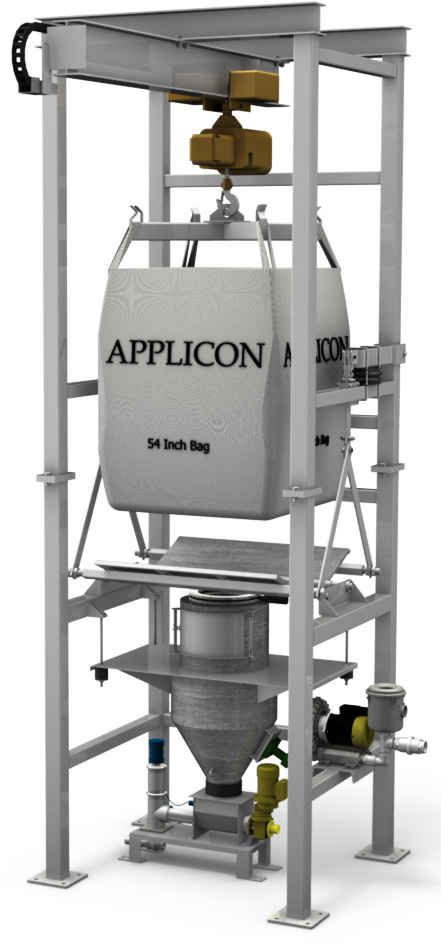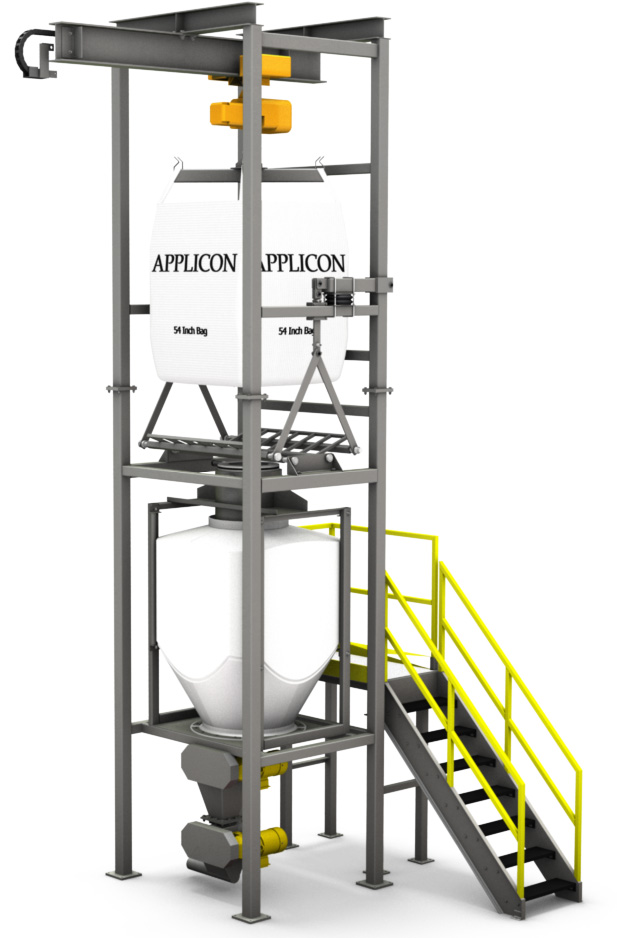


D.S.I.
Applicon builds systems for dispensing and metering dry sorbent powders such has hydrated lime, limestone, carbon, and activated carbon, for continuous injectiion into a gas stream for chemisorption of aerosol acids.
Safety
Safety is paramount when handling and extracting from 1 or 2 ton bags. Our system is uniquely designed to eliminate pinch points and crush zones, and to also provide reasonable headroom and workspace to open the sacks.
Bag, FIBC or Bulk
Very low rate injection may be served by simply dumping 50 lb. bags of sorbent. We offer bag dump stations with integral feeder and dust collection. Injection rates of 20 lb/hr or greater should consider sorbent delivered in big bags. We offer FIBC / bulk bag unloaders and dispensers with a range of features to make sorbent injection predicable and dependable, maintaining sorbent availability and flow with the least operator involvement.
SSak Emptying
Very fine powders often don't want to flow from the sack, but can also tend to aerate and flood once they do start moving. Thus, maintaining and controlling the flow from the bulk sack into the metering equipment is the first hurdle.
If there is sufficient headroom at the site, the simplest way to alleviate problems with extracting from the bulk bag, is to empty the bag instead of metering from it. Thus an operator can hoist, open, and discharge a full FIBC, and return the emptied sack to floor level in a matter of minutes. The holding bin provides a large storage buffer, and serves to de-aerate and condition the powder for subsequent metering.
Bag Extraction
Where headroom does not allow prompt emptying of the FIBC into a full size bin, we offer features to insure flow from the bulk sack. Our massage tables are powerful enough to lift and flex the bottom of the sack, inducing shear into the bridged material. This is safer and easier than lifting the bag with the hoist or forklift.
Feed Conditioning
For flowable fine granules, as for some activated carbons, a simple small hopper will do above the feeder. For powders, more effort is needed to present the feeder with sorbent of uniform density and flowability. Larger hoppers with stirred or activated bottom will accomplish this.
Feeding
Volumetric feeding is the least expensive, but offers no direct feedback that the sorbent is being metered accurately or at all. Proper feed conditioning helps insure the success of the feeder. Opacity monitoring and feedback will further insure that flow disruptions are minimized and dealt with either by manual intervention, or programmed actions like aerators, vibration, etc.
Loss in weight LIW feeding provides real time feedback and feeder response, in addition to programmed actions for upstream of feeder. However, gravimetric feeding is considerably more expensive and may require more height.
Injection
There are several ways to inject and broadcast powder into a stack or duct, under pressure. The least expensive is by an eductor, powered by plant compressed air, but because high pressure air is expensive to make and usually in short supply, the eductor can be powered by a small dedicated pressure blower. In either case, injection via eductor requires that the delivery route be relatively short in order to avoid potential blowback under changing duct or line conditions.
When a longer path is required for the injection line, we would use single or dual rotary valves. These do not feed quite so uniformly as an eductor, but are more practical for higher feed rates and longer distance.